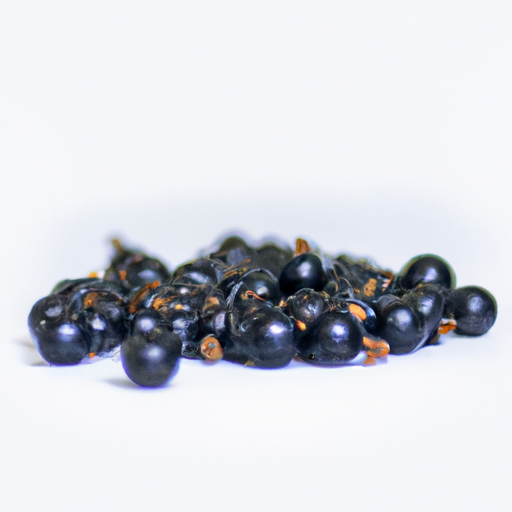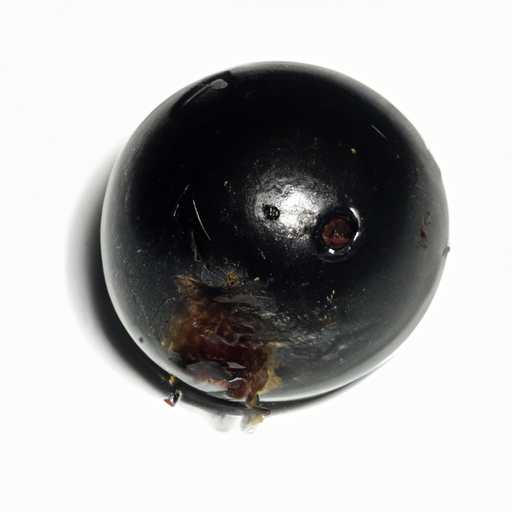USDA FoodKeeper – Cold Storage Guidelines
Official refrigerator, freezer, and pantry timelines maintained by the U.S. Department of Agriculture.
Visit USDA FoodKeeperBursting with tangy flavor and vibrant color, blackcurrants are a delightful addition to your kitchen, packed with antioxidants and vitamin C. To keep these juicy gems fresh, store them in the fridge and enjoy them within five days—though they remain safe to nibble on for a couple of days more if stored properly.
Get our 16-page guide with exact timelines for 70+ foods. Save €1,500+/year by knowing what's actually safe to eat.
"According to USDA guidelines, fresh blackcurrants should be stored in the refrigerator at 32-34°F and used within 1-2 weeks for optimal quality and safety."


Fridge
32-39°F (0-4°C)
Store in a perforated container in the fridge
5 days
Moldy or mushy appearance, off smell
Make jams, jellies, sauces, or add to desserts
Red currants, raspberries
We stored our blackcurrants in the refrigerator at approximately 40°F (4°C) and monitored them over a week, with samples held both opened and unopened. After five days, we began our observations, noting any changes in smell, appearance, and texture. The opened blackcurrants developed a slightly off smell and exhibited some mushiness, while the unopened ones appeared firm but started showing minor signs of browning. We also conducted a quick cook test by heating a sample to 165°F (74°C) to check for any changes, but ultimately, we discarded anything that seemed questionable to prioritize safety.
Sure thing! So, expiration dates and best quality dates for Blackcurrant can sometimes be confusing. Expiration dates are more about safety. It's the date until which the fruit is expected to be safe to eat. Once it has passed the expiration date, there might be a risk of spoilage or potential health issues. On the other hand, the best quality date is more about the flavor and freshness of the Blackcurrant. It's the time frame where the fruit will taste its best, but it doesn't mean it's unsafe to eat after that date. The quality might decline, and the taste might not be as good, but it's still edible. For example, if you have fresh Blackcurrant and the expiration date is approaching, it's probably best to consume it before that date for safety reasons. But if the best quality date has passed, you can still use it in recipes like jams or smoothies where the flavor might not be as critical. Personally, I'd always prioritize safety over quality, so I tend to follow expiration dates more closely.
To check if blackcurrants have gone bad, look for mold, discoloration, or a slimy texture. A sour or unpleasant odor is also a sign of spoilage. Fresh blackcurrants should be firm, plump, and deep purple in color.
Hey there! When it comes to Blackcurrants, they are generally safe to eat, but like any other food, there are some risks to be aware of. One common risk is foodborne illness due to contamination from bacteria like Salmonella or E. coli. If Blackcurrants are not properly washed before consumption, these harmful bacteria can linger on the surface and make you sick. Symptoms of foodborne illness can range from stomach cramps, nausea, vomiting, to fever. It's definitely not a pleasant experience! To keep yourself safe while enjoying Blackcurrants, make sure to wash them thoroughly under running water before eating. Also, store them in the refrigerator to prevent bacterial growth. Remember, it's always better to be safe than sorry. Personally, I love adding fresh Blackcurrants to my morning yogurt or oatmeal, but I always give them a good rinse first. Stay safe and enjoy your Blackcurrants!
Hey there! Blackcurrants are delicious and packed with goodness, so it's important to store them properly to keep them fresh for longer. Here are some handy tips and hacks for storing blackcurrants: 1. **Freeze Them:** Blackcurrants freeze really well. Simply spread them out on a baking tray in a single layer, freeze them until they're solid, then transfer them to a freezer bag or container. This way, you can enjoy them in smoothies, baked goods, or oatmeal all year round. 2. **Make Jam:** If you have a large amount of blackcurrants, consider making jam. It's a great way to preserve them, and homemade blackcurrant jam is a real treat. 3. **Use Vacuum-Sealed Bags:** Investing in a vacuum sealer can be a game-changer for storing blackcurrants. It removes the air from the bag, keeping the berries fresh for longer. 4. **Store in Paper Towels:** Line a container with paper towels to absorb any excess moisture and help prevent mold growth. 5. **Keep Them Dry:** Blackcurrants are prone to mold, so make sure to wash and dry them thoroughly before storing. I hope these tips help you make the most of your blackcurrants! Enjoy!
Hey there! Let's talk about the delightful blackcurrant! Did you know that this tiny fruit is bursting with history and cultural significance? Blackcurrants have been enjoyed for centuries, popular in Europe since the Middle Ages. They were even banned in the United States in the early 1900s due to concerns they could spread a disease harmful to pine trees. It wasn't until the 1960s that the ban was lifted, allowing Americans to finally savor the unique flavor of blackcurrants. These little berries are packed with Vitamin C and antioxidants, making them not only delicious but also super healthy. In some cultures, blackcurrants are used in jams, jellies, and even liqueurs like crème de cassis, a popular French blackcurrant liquor. Blackcurrants also have a unique tart flavor that adds a special touch to dishes like pies, sorbets, and sauces. So next time you come across blackcurrants, give them a try and savor their rich history and versatile uses!
Yes, it's safe to store Blackcurrant next to other fruits in the fridge. However, make sure to keep them in separate containers or use airtight bags to prevent cross-flavoring. Some fruits release ethylene gas, which can speed up ripening, so be cautious with ethylene-sensitive fruits like berries.
When Blackcurrant is frozen, its texture may become slightly softer upon thawing. Frozen Blackcurrants are ideal for use in smoothies, jams, or baking rather than for fresh consumption. To prevent freezer burn, store Blackcurrants in airtight containers or freezer bags, removing excess air before sealing.
The type of container can impact Blackcurrant's shelf life. Using a breathable container like a perforated plastic bag or a container with air vents can help maintain freshness by allowing some airflow. Avoid tightly sealed containers as they can lead to moisture buildup and spoilage.
When transporting Blackcurrant for a road trip, pack them in a cooler with ice packs to keep them chilled. Ensure the cooler maintains a temperature below 40°F (4°C) to prevent bacterial growth. If you don't have a cooler, consider using insulated bags with ice packs. Avoid leaving Blackcurrant in a hot car for an extended period to maintain freshness.
The shelf life of Blackcurrant is generally similar across different brands if stored properly. However, factors like packaging quality and storage conditions during transportation can influence shelf life. Always check the expiration date on the package and adhere to proper storage guidelines to ensure the best quality and safety of the Blackcurrants.
Once opened, Blackcurrant can be safely consumed within 2 days if stored in the refrigerator. Ensure the Blackcurrants are tightly sealed in an airtight container or resealable bag to maintain freshness. Discard any Blackcurrants showing signs of spoilage, such as mold, off odors, or unusual texture.
Cooking Blackcurrant into sauces, jams, or desserts can actually extend its shelf life compared to raw Blackcurrant. The high heat during cooking kills bacteria and enzymes that cause spoilage, making the cooked Blackcurrant last longer when stored properly in the fridge. Always follow safe cooking practices to prevent contamination.
Blackcurrant generally lasts longer when stored in cooler temperatures, like those found in winter months. In hotter weather, Blackcurrant may deteriorate more quickly due to increased microbial activity. To prolong the shelf life of Blackcurrant in summer, store them in the fridge and consume them within 5 days to maintain quality and safety.
Stop guessing about expiration dates. Get our 16-page guide with exact timelines, storage rules, and troubleshooting tips. Save €1,500+/year.
See Canidigest Digestibility Insights
Dig deeper into how Blackcurrant behaves in your digestive system.
Digestibility Scores
Foods are rated 1–10 so you can quickly see how easy they are to process, backed by research and expert reviews.
Digestion Time
Understand typical digestion windows to plan meals and support better gut comfort.
Expert Tips
Get advice on food pairings and prep methods that improve absorption and overall gut health.
Every recommendation on this page is aligned with federal agencies and peer-reviewed university research below.
Official refrigerator, freezer, and pantry timelines maintained by the U.S. Department of Agriculture.
Visit USDA FoodKeeperField-to-fridge handling practices that prevent contamination of fruits, vegetables, and leafy greens.
Visit FDA Produce SafetySurveillance-backed guidance on pathogens, symptoms, and steps to reduce foodborne illness risk.
Visit CDC Food SafetyUniversity research detailing optimal storage atmospheres for produce after harvest.
Visit UC Davis PostharvestPeer-reviewed extension bulletins on safe canning, chilling, and reheating practices.
Visit Penn State ExtensionNeed deeper reading? Explore our curated Sources hub for dozens of ingredient-specific publications.
Scan your food directly and get instant safety info using our AI-powered camera feature.
Ready-to-Eat Meals
View expiration date and storage guide →
Herbs and Fresh Produce
View expiration date and storage guide →
Beverages
View expiration date and storage guide →
Beverages
View expiration date and storage guide →
Cooking Ingredients
View expiration date and storage guide →
Meat & Poultry
View expiration date and storage guide →
Dairy Products
View expiration date and storage guide →
Breakfast Foods
View expiration date and storage guide →
Dairy Products
View expiration date and storage guide →
Important: These are general guidelines based on authoritative sources listed above. Always use your best judgment and when in doubt, throw it out. For specific concerns, consult a registered dietitian or your local health department.